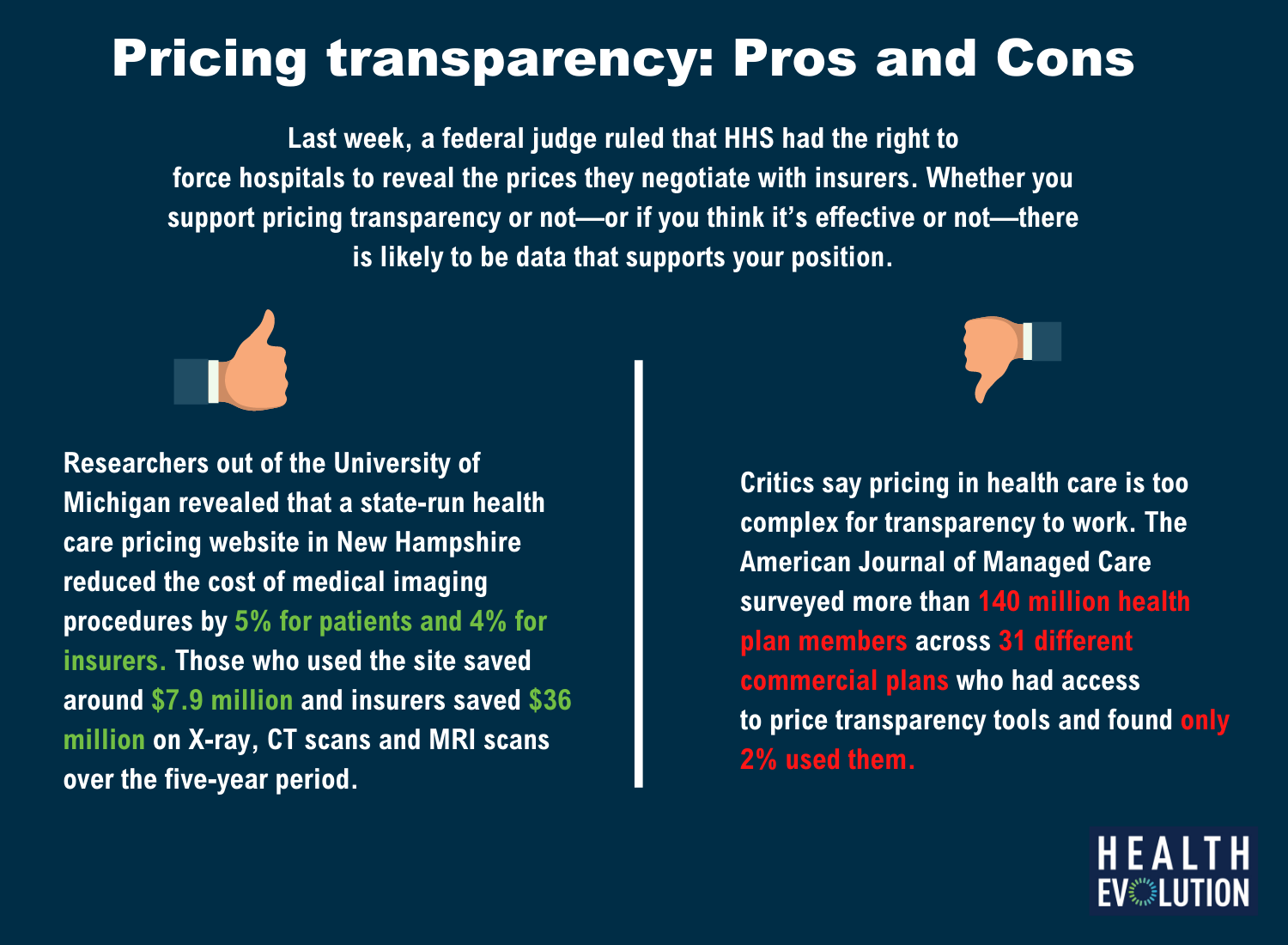Although controversial, the pricing transparency laws enacted by the Trump administration have taken another step toward finality.
Last week, a federal judge ruled that HHS had the right to require that hospitals reveal the prices they negotiate with insurers. U.S. District Judge Carl Nichols in Washington D.C. said HHS “fulfilled its duty to examine the evidence before it and connect it to the final rule.”
The rule, slated to go in effect at the start of next year, was challenged in court by the American Hospital Association on the grounds it exceeded the agency’s statutory authority, violates free speech and that the rule is arbitrary and capricious.
The case against price transparency
In a response to the ruling, AHA General Counsel Melinda Hatton said: “We are disappointed in today’s decision in favor of the administration’s flawed proposal to mandate disclosure of privately negotiated rates. The proposal does nothing to help patients understand their out-of-pocket costs. It also imposes significant burdens on hospitals at a time when resources are stretched thin and need to be devoted to patient care.”
The AHA will file an expedited appeal of the district court’s decision. Joining AHA in the challenge was the Association of American Medical Colleges, the Children’s Hospital Association and the Federation of American Hospitals.
On the payer side, America’s Health Insurance Plan is opposed to another Trump administration proposed rule around pricing transparency—which would force insurers to disclose negotiated rates for in-network providers and allowed amounts for out-of-network care. That rule has yet to be finalized but AHIP has released polling suggesting it would not be popular with its members.
One of the biggest criticisms of pricing transparency is that the pricing structure is too complex. “When you go to buy a new car, how would you feel if you showed up at the dealer and you find the car in the color you want, and the dealer representative hands you a telephone book size listing of all the components of your car? They tell you, ‘You’ve got everything in there to make a good choice for this car. It’s a lot of information, but it’s useless. That’s the nature of most health care purchasing decisions,” David Blumenthal, MD, president of the Commonwealth Fund, said to Health Evolution.
The case in favor of price transparency
When the provider rules were finalized and the payer rules introduced, Health Evolution Chairman David Brailer, MD, called on CEOs to support price tranparency to help drive industry-wide progress toward value-based care because enabling consumers to understand and make decisions based on pricing is at the core of any efficient market.
“None of us want to buy anything without shopping around and finding the best price. This may not always be the lowest price – we may pay more to a reliable seller with a good reputation or for more add-ons,” Brailer wrote. “But we can’t perform this most basic market behavior without discovering what the price is across a landscape of sellers. With each buyer seeking out the ‘best’ price they can find, and each seller selling for the ‘best’ price they can offer, markets function, goods are traded and capital is allocated.”
A study from researchers out of the University of Michigan, for instance, revealed that a state-run health care pricing website in New Hampshire reduced the cost of medical imaging procedures by 5 percent for patients and 4 percent for insurers. Researchers say those who used the site saved around $7.9 million and insurers saved $36 million on X-ray, CT scans and MRI scans over the five-year period. By the fifth year, out-of-pocket prices were 11 percent lower for patients.
Researchers at the RAND corporation found that a program that incentivizes price shopping in California find spurred “provider price competition” and “sizable decreases in medical spending.” They estimate that the program leads to a 2.1% decrease in provider prices.
The overarching question: Will price transparency work?
More research from California Healthline found wild variations in the prices for procedures—for instance, the list price on a liter of basic saline solution for intravenous use ranged from $56 to $383.
But does having that information save patients in costs? Not if they don’t use any tools. The American Journal of Managed Care surveyed more than 140 million health plan members across 31 different commercial plans who had access to price transparency tools and found only 2 percent used them. This supports many providers’ and payers’ theory that pricing is too complex for transparency to be effective. Another study from Aetna shows that only 3.5 percent of members used pricing transparency tools.
There is evidence that consumers don’t use the tools even when they are more responsible the cost of their own care. That was one of the findings in research published in The Quarterly Journal of Economics that found consumers did not price shop for cheaper care when switched into a high-deductible plan.
“The concept is absolutely the right thing to do, but we who run the hospitals and health care systems know how complex that is,” said Karen Teitelbaum, CEO of Sinai Health System in Chicago. “I can tell you an MRI is going to be X amount of dollars, but if there’s a complication…that price is going to be different. It’s going to be extraordinarily difficult and onerous to execute accurately.”
Do you support pricing transparency? Email us here or send us a tweet to let us know.










